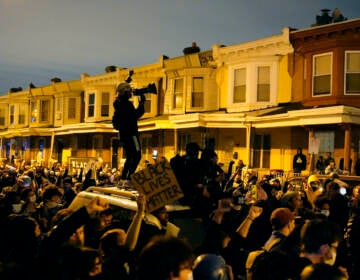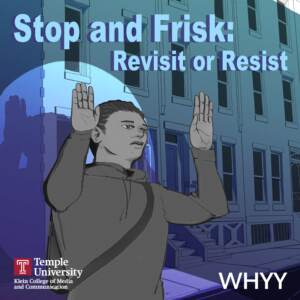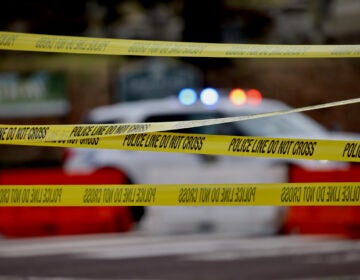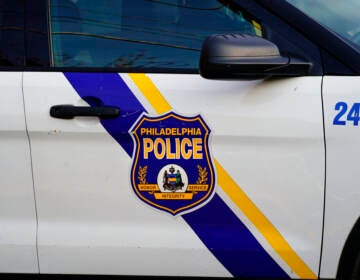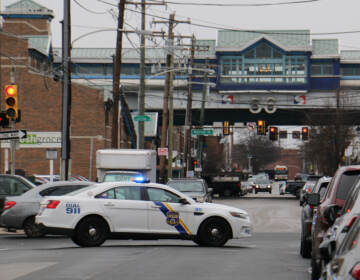Philly police work to staff up despite distrust, ongoing gun violence crisis
The PPD is low on officers, and recruitment heads say they are trying new tactics like offering physical fitness classes and lowering the sign-up age to 20 years old.
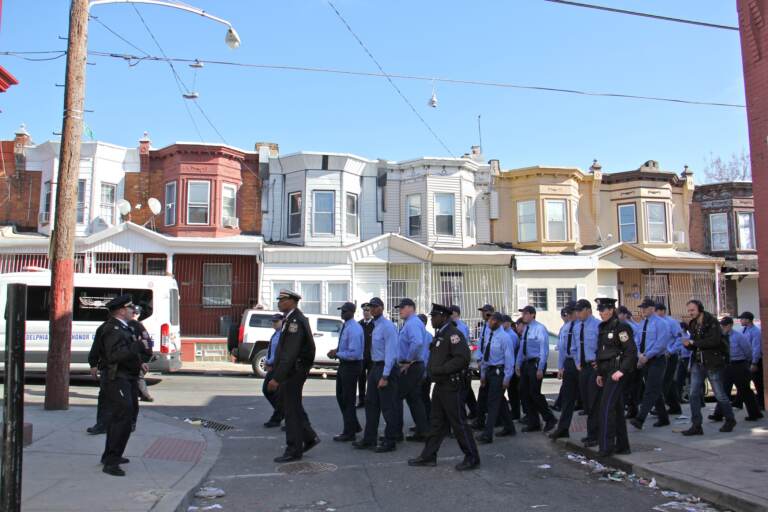
Philadelphia police cadets tour the streets of Kensington. (Emma Lee/WHYY)
This story is from Stop and Frisk, a podcast production from WHYY News and Temple University’s Logan Center for Urban Investigative Reporting
Find it on Apple Podcasts, Spotify, or wherever you get your podcasts.
How do you feel about stop and frisk (and policing more broadly) as an answer to Philly’s gun violence crisis? Get in touch
Tyrell McCoy was 19 years old when he joined the Philadelphia Police Department in 2007. He was living in North Philly, and he said his feelings about officers in his neighborhood were “mixed.”
“I had friends that had been stopped by police, that I believe was not constitutionally sound,” he said.
McCoy said witnessing those incidents motivated him to start patrolling his own streets as an officer. He felt being a young Black man on the police force could help rebuild trust with residents who were skeptical of law enforcement. He’s now captain of the background investigations and recruitment unit for PPD, charged with bringing more officers onto the force.
“We’re in an interesting time in policing,” McCoy said. “This is an opportunity for us to engage with [young people] and say, ‘Listen, if you want to be the change, come onboard.’”
Recruiting is a daunting task given the police department’s officer shortage and the national anti-police sentiment that reached a tipping point after George Floyd’s murder. But department administrators contend more officers are needed to tackle Philly’s ongoing gun violence crisis.
“We are addressing increased volume with less people,” said PPD Commissioner Danielle Outlaw at an October town hall, noting staffing numbers are down significantly from when she took office almost three years ago. “That doesn’t mean we stop doing what we need to do.”
Outlaw did not respond to multiple WHYY News requests for an interview.
While some Philadelphians are calling for increased police presence — even the return of controversial policing practices such as stop and frisk — to curb gun violence, some residents don’t believe staffing up will help prevent shootings.
Learn more about the debate over policing and public safety by listening to “Stop and Frisk: Revisit or Resist”, a podcast produced by WHYY News and Temple University’s Logan Center for Urban Investigative Reporting.
The officer shortage
A recent audit of the PPD from the Office of the Controller found that there were 5,983 uniformed officers on staff at the end of 2022, down from 6,590 in 2019. Audit authors estimate that number could fall 13% to 5,200 by the end of fiscal year 2025. The current staffing numbers include officers who are injured on duty.
From 2017 to 2022, there were an average of 11 officers assigned to low-crime districts and 22 officers assigned to high-crime districts “at any particular time during the day,” according to the audit. The report also found the department sends 78% as many officers to the East Division — which includes Kensington, a hotspot for gun violence and drug trafficking — as it did five years ago.
Of the department’s 6,000 officers, 2,500 are assigned to patrol. Other officers perform administrative work, such as delivering mail, according to the audit.
In November, the city announced an agreement with the Fraternal Order of Police which allows the department to hire civilians for certain jobs, including body-worn camera footage review, traffic enforcement, and abandoned vehicle removal.
Adam Geer, the city’s Deputy Inspector General for public safety, said increasing the number of patrol officers is a step toward building better relationships between the community and the police.
“So that we can get the information on the individuals who are causing the most problems,” he said.
From 2016 to 2020, Philadelphia had the lowest homicide clearance rate of the 10 largest cities in the U.S., according to the police audit. That’s despite the fact that the PPD’s budget has been growing — from about $673 million in 2018 to roughly $741 million in 2020, according to a controller’s office budget analysis. Gun homicides spiked during that time, from 353 to 499, according to police data.
The 2023 city budget includes $788 million for police, which is an increase of $30 million from the year prior and totals more than the allotment for public health, parks and recreation, streets and sanitation and human services combined, according to the budget document.
The department has instituted a few changes to try to grow their ranks, McCoy said, including allowing people as young as age 20 to sign up for the police academy.
Kendra Van de Water is executive director for YEAH Philly, a West Philadelphia resource center serving young adults involved with the criminal justice system. She said city funding should be funneled into social services, not officer salaries.
“We need to be investing in people directly,” she said. “We need to be helping people get access to things that they need— -affordable housing, food, all these things that the people in our city do not have access to.”
Rebuilding the force
As fatal shootings continue, there’s been a wide range of ideas on public safety from police department representatives, school officials, mayoral candidates, and criminal justice experts, many of them involving shoring up the police force.
Former City Council member and mayoral candidate Cherelle Parker released a Neighborhood Safety and Community Policing Plan last spring, which called for a $1 million police recruitment budget boost. The city did allocate an additional $250,000 from the current budget for recruitment according to a city council spokesperson.
Many proponents of bolstering police ranks argue more officers will make it easier to implement community policing. It’s an umbrella strategy that can include having more officers patrolling neighborhoods on foot or bike, giving officers more long-term assignments, having officers meet people door-to-door or at community events, or other strategies. The U.S. Department of Justice says this model can help officers incorporate residents’ concerns into a policing strategy and improve trust.
The PPD has also been allocating resources toward a different strategy called “hot spots” policing, which the National Institute of Justice defines as concentrating on specific geographic areas where crime is rampant. Since 2019, the Philadelphia Police Department has used a hot spots strategy called Operation Pinpoint to deploy officers to areas in greatest need. Police data from September shows shootings are down 4% in the city’s 45 pinpoint areas, though the audit from the controller’s office indicates that there’s never been a formal, independent evaluation of the program.
Joe Sullivan, a former PPD deputy commissioner who was just selected as chief of police in Wichita, Kansas, says both of the above strategies have been hampered by the staffing shortage, which he says worsened when Mayor Jim Kenney rescinded a budget increase for police in the wake of 2020’s Black Lives Matter protests.
“They were denied a budget increase, academy classes were canceled, the authorized strength of the department was reduced,” Sullivan said. “They instituted a residency requirement…and that’s what got us where we’re at.”
He’s referring to a rule, established in 2020, requiring that aspiring police officers live in the city of Philadelphia for one year to be eligible for hire.
Mayor Jim Kenney has pointed to the restriction as a reason for the police department’s struggle to hire officers. The department changed the policy in March of this year. Now, new officers are required to move into the city within one year of being hired.
Sullivan said these steps, combined with the “civilization” efforts now allowed by the new contract agreement, are only a start.
“We waited too long to hit the panic button over the manpower issue,” he said. “And now I can’t even begin to imagine how many years it will take to build the department back up.”
‘Inherent dangers’
On a recent evening there 18 officers were assigned to patrol the 24th police district, a large swathe of the city encompassing Kensington and Allegheny avenues. It’s an area notorious for open-air drug sales, and it’s seen more fatal shootings in 2022 than any other police district.
There’s a police station, not far from the neighborhood’s chaotic epicenter at the Allegheny SEPTA station, where officers start their day and receive their shift assignments. A sergeant who gave WHYY News a tour of the station said most of the patrol officers are young recruits who land here after graduating from the academy.
Sgt. Michael Spicer told WHYY that they are trying to put as many officers on foot or on bikes as possible, and that it’s up to these patrol officers to relocate the hundreds of drug users that occupy the sidewalks and parks on a daily basis.
“The ones that are on foot, they’ll get them moved,” Spicer said, noting that the number of drug users camped out is “much larger in volume” than the number of officers assigned to the area.
Spicer was charged with beating drug dealers and stealing their money in 2012. He was acquitted and reinstated to the force in 2015.
McCoy, the recruitment commander, says there are “inherent dangers” to being a police officer in Philadelphia. But, there are also draws.
“As cliché as it may sound, a number of people come on this job to help and to be that change,” he said. “And, I think this is an opportunity.”
The PPD offers new recruits to the police academy a starting salary of just under $60,000 a year, with the potential to make just over $83,000 by year four, according to the department’s recruitment materials. The median annual pay for police and sheriff patrol officers is $64,600 according to the Bureau of Labor Statistics. In November, The Philadelphia Inquirer reported that the Metropolitan Police Department in Washington D.C. has been recruiting Philadelphia residents to join their force at a slightly higher salary.
None of this deters McCoy. He says he has a list of somewhere between 1,600 and 1,700 people who expressed interest in the police academy during the last enrollment period in September. A few hundred of them are participating in the department’s new physical agility class — meant to get people who are interested in the academy to the necessary fitness level to pass the test.
“We are encouraged by the numbers we’re seeing,” he said. “Our really big key selling point is that we’ll help you out.”
He said the department will continue to recruit at universities, recreation centers, and community events, and will tailor their strategy to appeal to young people and especially young people of color.
McCoy said he loves talking to young people about his work.
“You really have to humanize the badge,” he said. “Understand that this uniform, yes, it’s a barrier to communication sometimes.”
He said he recognizes that in many of Philadelphia’s predominantly Black neighborhoods, there is a deep distrust in police, and it gets worse when a police officer commits “an egregious action” against a Black person somewhere else in the country.
“That’s going to affect us here in Philadelphia, regardless of what we want to think,” he said.
He said he combats those misconceptions by having honest, one-on-one conversations with residents, even with those who are skeptical.
“Our young people know exactly what’s going on,” he said. “Right now [we’re] trying to figure out how to better engage with them, ultimately to stop the number of violent incidents that we have involving our young people in our city.”
The current recruitment cycle ends on Jan. 6, 2023.
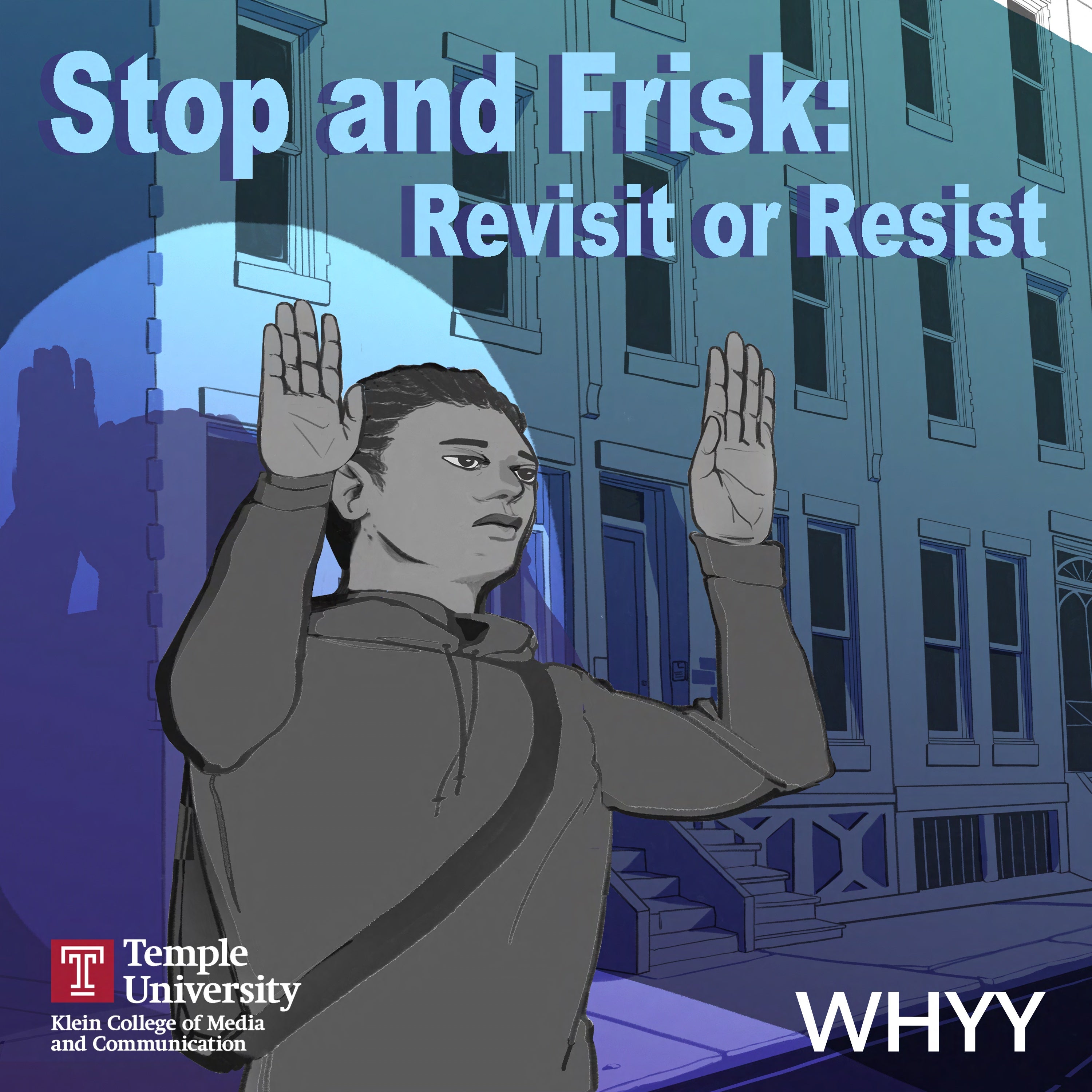
Stop and Frisk: Revisit or Resist
WHYY is your source for fact-based, in-depth journalism and information. As a nonprofit organization, we rely on financial support from readers like you. Please give today.


